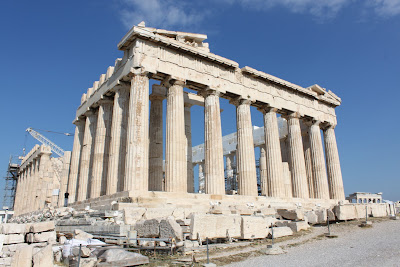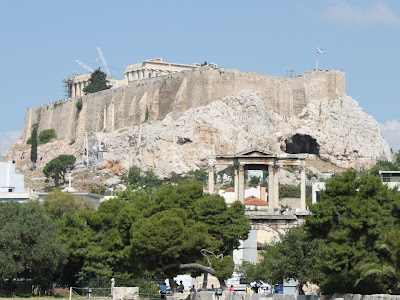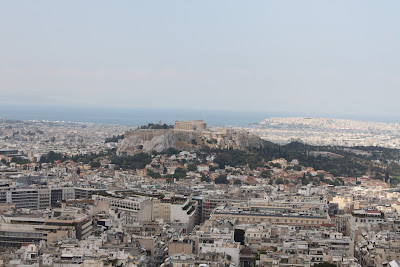In looking through some notes today I realized that while I’ve written about five of the ancient temples I visited earlier this year, I never wrote about the most famous of them, the Parthenon in Athens.
The Parthenon, dedicated to Athena Parthenos, is the largest structure on the Acropolis of Athens. It was completed in 438 BCE and was used as a temple for over 800 years until 435 CE, when the Christian Byzantine emperor ordered it closed. Sometime before 600 it was converted to a Christian church, which it remained until Athens was conquered by the Turks, who converted it to a mosque some time in the 1460s.
As late as 1687 the Parthenon was in excellent condition. But in that year Venetian armies attempted to capture Athens, the Turks used the Parthenon as a munitions dump, the Venetians attacked it with cannon fire and it exploded. Most of the damage we see today was caused by that explosion.
 |
| the Southeast corner of the Parthnon |
Then in 1806 Thomas Bruce removed many of the pediment sculptures and carried them off to England. Today the Elgin Marbles remain in the British Museum despite Greek efforts to have them returned.
Restoration has been underway since 1983, but as with work on most other ancient sites, the main effort is on preserving existing ruins and not on a full reconstruction. If you want to see what the Parthenon looked like in ancient times, go to Nashville.
Some sources claim the Parthenon was more a civic structure than a religious one. Even if that’s true by our standards, I’m not sure the ancient Greeks would have made such a clear distinction.
At some of the other temples I got a sense of the presence of a god or goddess. What I felt here was more general but very strong. Perhaps this was simply the mundane effect of being in a high place overlooking a large city. Or perhaps this is a natural place of power and sacred site. Whatever the source, the Parthenon is a place of wonder and awe.
 |
| the West end of the Parthenon |
If you have the opportunity to visit the Acropolis, go early. Tour buses from the cruise terminal in Piraeus start arriving not long after it opens and it gets crowded in a hurry. Plus Athens is a hot city and there is no shade on the Acropolis. We arrived shortly after it opened at 8:00 AM – the temperatures and the crowds were tolerable. By the time we left at 10:30 it was already unpleasantly warm and unpleasantly crowded.
The Parthenon reminds me a little of Stonehenge. It’s a well-known site and it’s popular with tourists. It’s easy to get caught up in the history, distracted by the crowds, and forget that for hundreds of years it was a sacred place.
And for some of us, it still is.
 |
| the Acropolis from the Temple of Zeus |















